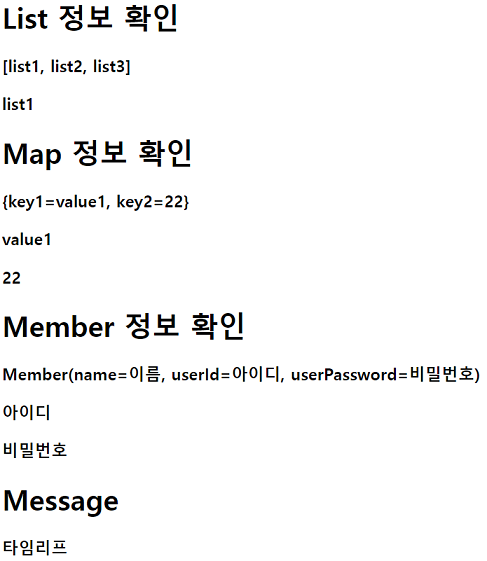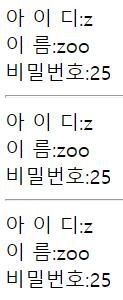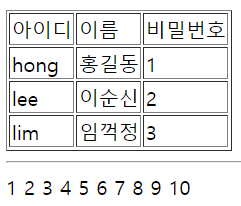Spring (7) - View Template
- 개발 환경 준비 1)
- Spring IoC 1) 2)
- Spring MVC 1) 2) 3)
Database 활용- View Template 1) 2) 3) 4) 5)
- AOP / Filter / Interceptor
- File Upload / Download
Thymeleaf
- Spring Boot 에서 권장하는 View Template
- HTML5 문법을 사용하는 HTML 태그 및 속성 기반의 Template Engine
- 텍스트, HTML, XML, JavaScript, CSS 등에 사용 가능하다.
- Controller에서 View로 넘겨준 Model을 이용하여 내용을 출력한다.
HTML
<h3>[[${list}]]</h3>
file\src\main\java\com\example\basic\controller\HtmlController.java
Java
1
2
3
4
5
6
7
8
9
10
11
12
13
14
15
16
17
18
19
20
21
22
23
24
25
26
...
@GetMapping("welcome")
public String welcome(Model model){
ArrayList<String> list = new ArrayList<>();
list.add("list1");
list.add("list2");
list.add("list3");
model.addAttribute("list", list);
Map<String, Object> map = new HashMap<>();
map.put("key1", "value1");
map.put("key2", 22);
model.addAttribute("map", map);
Member member = new Member();
member.setName("이름");
member.setUserId("아이디");
member.setUserPassword("비밀번호");
model.addAttribute("member", member);
model.addAttribute("message", "타임리프");
return "welcome";
}
...
file\src\main\resources\templates\welcome.html
HTML
1
2
3
4
5
6
7
8
9
10
11
12
13
14
15
16
17
18
19
20
21
22
23
24
25
<html xmlns:th="http://www.thymeleaf.org">
<head>
</head>
<body>
<h1>List 정보 확인</h1>
<h3>[[${list}]]</h3>
<h3>[[${list[0]}]]</h3>
<h1>Map 정보 확인</h1>
<h3>[[${map}]]</h3>
<h3>[[${map.key1}]]</h3>
<h3>[[${map['key2']}]]</h3>
<h1>Member 정보 확인</h1>
<h3>[[${member}]]</h3>
<h3>[[${member['userId']}]]</h3>
<h3>[[${member.userPassword}]]</h3>
<h1>Message</h1>
<h3>[[${message}]]</h3>
</body>
</html>
http://localhost:8080/welcome
Variable Expression : ${…}
file\src\main\java\com\example\basic\controller\ThymeleafController.java
Java
1
2
3
4
5
6
7
8
9
10
11
12
13
14
15
16
17
18
19
20
21
package com.example.basic.controller;
import java.util.HashMap;
import java.util.Map;
import org.springframework.stereotype.Controller;
import org.springframework.ui.Model;
import org.springframework.web.bind.annotation.GetMapping;
@Controller
public class ThymeleafController {
@GetMapping("user")
public String user(Model model) {
Map<String, Object> user = new HashMap<>();
user.put("userId", "z");
user.put("userName", "zoo");
user.put("userAge", 25);
model.addAttribute("user", user);
return "user";
}
}
file\src\main\resources\templates\user.html
HTML
1
2
3
4
5
6
7
8
9
10
11
12
13
14
15
16
17
18
19
20
21
22
23
24
25
26
<html xmlns:th="http://www.thymeleaf.org">
<head>
</head>
<body>
<!-- thymeleaf 표현법 -->
<!-- 1. 열리는 tag와 닫히는 tag사이에 표현 -->
<!-- span 태그 : 별도의 영역이 없는 태그,
데이터의 크기만큼 영역이 잡힘 -->
아 이 디:<span>[[${user.userId}]]</span><br>
이 름:<span>[[${user.userName}]]</span><br>
비밀번호:<span>[[${user.userPw}]]</span><br>
<hr>
<!-- 2. 열리는 tag에 th:속성명="값" 으로 표현 -->
아 이 디:<span th:text="${user.userId}"></span><br>
이 름:<span th:text="${user.userName}"></span><br>
비밀번호:<span th:text="${user.userPw}"></span><br>
<hr>
<!-- 3. 열리는 tag에 data-th-속성명="값" 으로 표현 -->
아 이 디:<span data-th-text="${user.userId}"></span><br>
이 름:<span data-th-text="${user.userName}"></span><br>
비밀번호:<span data-th-text="${user.userPw}"></span><br>
</body>
</html>
http://localhost:8080/user
- 문법의 차이에 따라 여러 방법이 있다.
- 단순 문자열 데이터 표현 방법
- 열리는 태그 안에 속성값을 넣는 방식, 기능을 나타내는 문법(text표현)
Iteration - th:each
- 반복작업을 표현하는 방법 (반복문)
file\src\main\java\com\example\basic\controller\ThymeleafController.java
Java
1
2
3
4
5
6
7
8
9
10
11
12
13
14
15
16
17
18
19
20
21
22
23
24
25
26
27
28
...
@GetMapping("userlist")
public String userList(Model model) {
List<Member> userList = new ArrayList<>();
Member member = new Member();
member.setName("홍길동");
member.setUserId("hong");
member.setUserPassword("1");
userList.add(member);
member = new Member();
member.setName("이순신");
member.setUserId("lee");
member.setUserPassword("2");
userList.add(member);
member = new Member();
member.setName("임꺽정");
member.setUserId("lim");
member.setUserPassword("3");
userList.add(member);
model.addAttribute("userList", userList);
return "userList";
}
...
file\src\main\resources\templates\userList.html
HTML
1
2
3
4
5
6
7
8
9
10
11
12
13
14
15
16
17
18
19
20
21
22
23
24
25
<html xmlns:th="http://www.thymeleaf.org">
<head>
</head>
<body>
<table border="1">
<tr>
<td>아이디</td>
<td>이름</td>
<td>비밀번호</td>
</tr>
<tr th:each="member : ${memberList}">
<td th:text="${member.userId}"></td>
<td th:text="${member.Name}"></td>
<td th:text="${member.userPassword}"></td>
</tr>
</table>
<hr>
<th:block th:each="pageNumber : ${#numbers.sequence(1, 10)}">
<span th:text="${pageNumber}"></span>
</th:block>
</body>
</html>
http://localhost:8080/userlist
Conditional Evaluaiton - th:if, th:unless, th:switch
- Thymeleaf의 if, else, switch 조건문
file\src\main\java\com\example\basic\controller\ThymeleafController.java
Java
1
2
3
4
5
6
7
8
9
10
11
12
13
14
15
...
@GetMapping("mode")
public String mode(Model model, @RequestParam Map<String, Object> map) {
// 동적 파라미터의 데이터가 잘 들어오는지 체크
// for (String data : map.keySet()) {
// System.out.println(map.get(data));
// }
model.addAttribute("name", map.get("name"));
model.addAttribute("auth", map.get("auth"));
model.addAttribute("category", map.get("category"));
return "mode";
}
...
file\src\main\resources\templates\mode.html
HTML
1
2
3
4
5
6
7
8
9
10
11
12
13
14
15
16
17
18
19
20
21
22
23
24
25
26
27
<html xmlns:th="http://www.thymeleaf.org">
<head>
</head>
<body>
<h1>타임리프 조건문 활용</h1>
관리자 이름 :
<!-- 조건식이 참일 경우 -->
<span th:if="${name} != null" th:text="${name}"></span>
<!-- 조건식이 거짓일 경우 -->
<span th:unless="${name} != null" th:text="이름없음"></span>
<br>
권한 :
<!-- 삼항 연산자 -->
<span th:text="${auth} != null ? ${auth} : '권한없음'"></span>
<br>
담당 카테고리 :
<!-- switch문 -->
<span th:switch="${category}">
<span th:case="1">커뮤니티</span>
<span th:case="2">장터</span>
<span th:case="3">갤러리</span>
</span>
</body>
</html>
http://localhost:8080/mode
http://localhost:8080/mode?name=사용자&auth=456&category=3
연습
- Thymeleaf 조건문 활용 연습
file\src\main\java\com\example\basic\controller\ThymeleafController.java
Java
1
2
3
4
5
6
7
8
9
10
11
12
13
14
15
16
17
18
19
20
21
22
23
24
25
26
27
28
29
...
@GetMapping("member")
public String gerUser(Model model, @RequestParam String userId){
List<Member> memberList = new ArrayList<>();
Member member = new Member();
member.setName("홍길동");
member.setUserId("1");
member.setUserPassword("123");
memberList.add(member);
member = new Member();
member.setName("이순신");
member.setUserId("2");
member.setUserPassword("456");
memberList.add(member);
member = new Member();
member.setName("임꺽정");
member.setUserId("3");
member.setUserPassword("789");
memberList.add(member);
model.addAttribute("memberList", memberList);
model.addAttribute("userId", userId);
return "member";
}
...
- 파라미터 userId 값에 따라 해당하는 userId 값과 동일한 유저정보만 출력되게 작성해보자
-
예) http://localhost:8080/member?userId=1 접속 시 홍길동의 정보만 출력
- each반복문과 if문 사용
file\src\main\resources\templates\member.html
HTML
1
2
3
4
5
6
7
8
9
10
11
12
13
14
15
16
17
18
19
20
21
22
<html xmlns:th="http://www.thymeleaf.org">
<head>
</head>
<body>
<table border="1">
<tr>
<td>아이디</td>
<td>이름</td>
<td>비밀번호</td>
</tr>
<tr th:each="member : ${memberList}">
<span th:if="${userId} == ${member.userId}">
<td th:text="${member.userId}"></td>
<td th:text="${member.name}"></td>
<td th:text="${member.userPassword}"></td>
</span>
</tr>
</body>
</html>
- switch문 활용
HTML
1
2
3
4
5
6
7
8
9
10
11
12
13
14
15
16
17
18
19
20
21
22
23
24
25
26
27
28
29
30
31
32
<html xmlns:th="http://www.thymeleaf.org">
<head>
</head>
<body>
<table border="1">
<tr>
<td>아이디</td>
<td>이름</td>
<td>비밀번호</td>
</tr>
<span th:switch="${userId}">
<tr th:case="1">
<td th:text="${memberList[0].userId}"></td>
<td th:text="${memberList[0].name}"></td>
<td th:text="${memberList[0].userPassword}"></td>
</tr>
<tr th:case="2">
<td th:text="${memberList[1].userId}"></td>
<td th:text="${memberList[1].name}"></td>
<td th:text="${memberList[1].userPassword}"></td>
</tr>
<tr th:case="3">
<td th:text="${memberList[2].userId}"></td>
<td th:text="${memberList[2].name}"></td>
<td th:text="${memberList[2].userPassword}"></td>
</tr>
</span>
</body>
</html>
http://localhost:8080/member?userId=2
Reference
- 이 포스트는 SeSAC 인공지능 SW 개발자 양성 과정 - 김영식 강사님의 강의내용을 정리한 것입니다.







댓글남기기